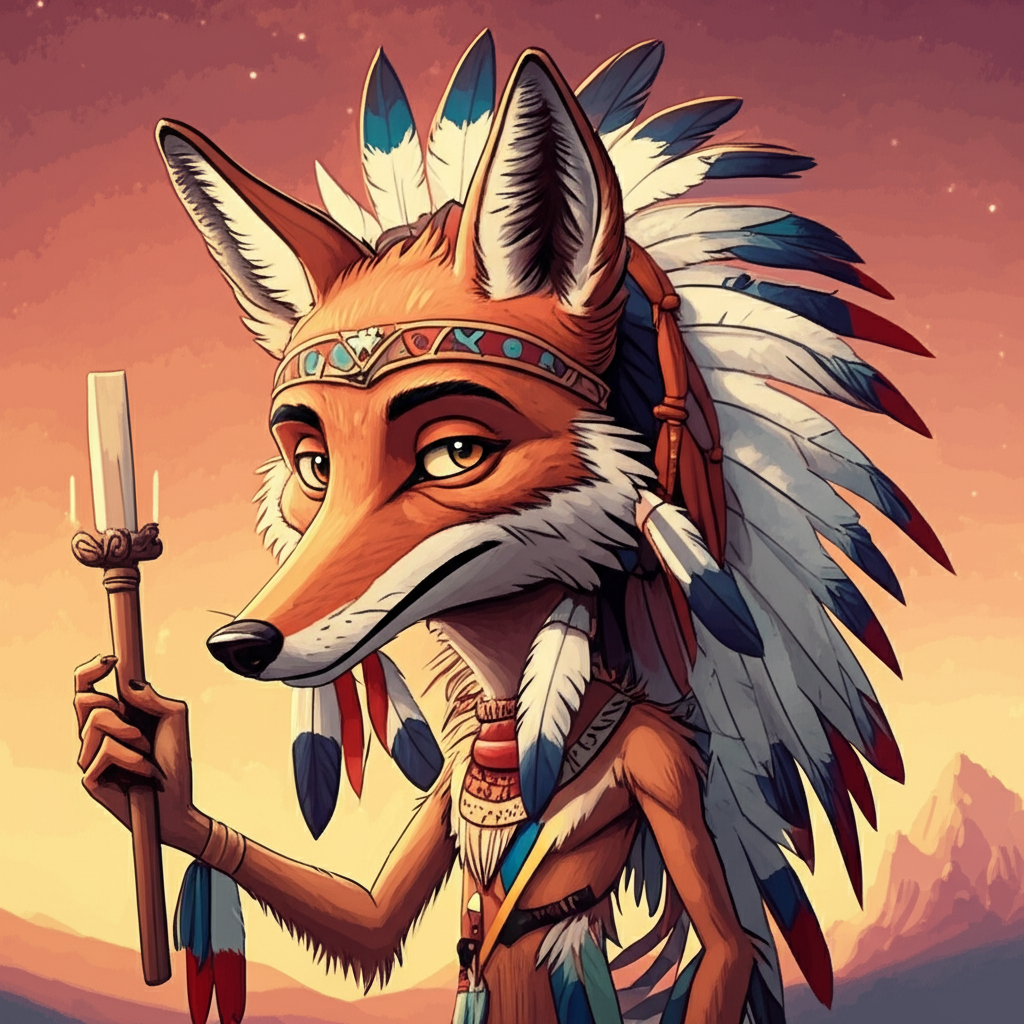
In the vast, wind-swept plains that cradle the heart of North America, where the sky stretches in an endless blue embrace and the earth breathes stories of ages past, ancient peoples wove narratives of creation, of survival, and of the intricate dance between the seen and the unseen. Among these timeless tales, passed down through generations around crackling fires, are those that feature the cunning Coyote, a figure as ubiquitous to the landscape as the prairie grasses themselves. This particular story, the "Trial of the White Buffalo Prophecy," is a profound example of such folklore, a traditional narrative told by ancient peoples to explore their understanding of the world and their place within it.
The cultural era in which these myths were shared was one deeply intertwined with the rhythms of nature. For many Indigenous peoples of the Great Plains, the world was a living, breathing entity, animated by spirits and guided by forces that could be both benevolent and fearsome. The changing seasons, the migrations of buffalo herds, the silent vigil of the stars – all held meaning and were seen as manifestations of a grander order. Their worldview was not one of separation between humanity and the natural world, but rather a profound interconnectedness. The land provided sustenance, shelter, and spiritual guidance. Animals were not merely creatures of flesh and bone, but often held spiritual significance, embodying traits and lessons that could inform human life. It was in this context of deep reverence for the natural world and a belief in the spiritual essence of all things that stories like the one of Coyote and the White Buffalo Prophecy took root and flourished.
At the heart of this narrative stands Coyote, a figure of immense complexity within the folklore of many Plains tribes. He is not a god to be worshipped, nor a simple animal. Instead, Coyote embodies the spirit of the trickster. This archetype, found across numerous cultures, is a being of dual nature: he can be foolish and selfish, bringing about his own downfall through his insatiable curiosity and greed. Yet, paradoxically, his often-unintentional mischief can also lead to beneficial outcomes, the creation of something new, or the illumination of a fundamental truth. Coyote is often portrayed with sharp senses, a quick wit, and an almost boundless capacity for improvisation. His symbolic attributes lie in his ability to disrupt the established order, to challenge convention, and to embody the unpredictable nature of existence. He is the agent of change, the catalyst for the unexpected, and a constant reminder that the world is rarely as simple as it seems.
The "Trial of the White Buffalo Prophecy" unfolds as a narrative woven with the threads of the sacred and the mundane. The story begins with a time of great upheaval on the plains. The buffalo, the lifeblood of the people, were dwindling. Their once-mighty herds were scattered, their numbers thinned by hardship and perhaps by a growing imbalance in the natural world. Amidst this scarcity, a profound prophecy began to circulate – a vision of a White Buffalo Calf Woman, a sacred being who would emerge to restore balance and abundance.
Coyote, ever the opportunist and always drawn to anything that promised wonder or potential gain, heard the whispers of this prophecy. He was not moved by the solemnity of the people’s plight, nor by the reverence they held for the sacred vision. Instead, he saw an opportunity for himself. He imagined being the one to discover the White Buffalo Calf Woman, to be heralded as the hero, to perhaps even control her power. With a mischievous glint in his eye and a spring in his step, he set out across the vast plains, his senses sharp, his mind churning with schemes.
His journey was not a straightforward pursuit of sacredness, but a series of encounters, each designed to test his own character and to gauge the sincerity of those he met. He encountered a band of hunters, their faces etched with worry, their larders bare. He tried to trick them, to mislead them into believing he knew the secret location of the White Buffalo Calf Woman, hoping to barter their meager supplies for his fabricated knowledge. But their quiet desperation and their genuine respect for the buffalo taught him a lesson in humility, a fleeting moment where his usual cunning was met with a quiet dignity he couldn’t quite comprehend.
He met a wise elder, her eyes reflecting the wisdom of countless seasons. He tried to impress her with his supposed knowledge of the prophecy, boasting of his keen instincts. But the elder, seeing through his bravado, simply offered him a cup of water and spoke of patience and inner strength, qualities Coyote sorely lacked. He felt a flicker of shame, a rare sensation that he quickly dismissed.
As Coyote continued his wanderings, his ego bruised and his stomach empty, he began to feel the weight of the plains, the silent judgment of the wind and the sky. He stumbled upon a small, isolated dwelling where a family sat huddled, sharing the last of their dried berries. He expected to be met with suspicion, but instead, he was offered a share of their meager meal. In their simple act of kindness, in their shared hope for the return of the buffalo, Coyote witnessed a different kind of strength – one rooted not in trickery, but in community and resilience.
Finally, on a distant ridge, silhouetted against the setting sun, he saw it. Not a trick, not a mirage, but a magnificent White Buffalo Calf. It was smaller than the adult buffalo, its coat a luminous white, radiating an aura of peace and profound power. Beside it stood a woman of ethereal beauty, her presence calming and radiating wisdom. This was the fulfillment of the prophecy.
Coyote, for the first time, felt a genuine awe, a sense of his own smallness in the face of such sacredness. He wanted to rush forward, to claim a part of this miracle, but he found his paws rooted to the earth. The White Buffalo Calf Woman looked at him, not with anger or disdain, but with a gaze that seemed to penetrate his very being, acknowledging his presence without judgment.
The White Buffalo Calf Woman, in the traditional telling, then proceeded to impart her teachings, her presence a catalyst for renewal. The story doesn’t detail Coyote’s specific role in the aftermath, but his presence signifies the universal nature of these prophecies, touching even the most wayward of beings. He was a witness, a part of the grand unfolding, a reminder that even the trickster can be present at moments of profound spiritual significance.
The symbolism woven into this myth is rich and multifaceted. The White Buffalo Calf itself is a powerful symbol of purity, hope, and spiritual renewal. Its appearance signifies a turning point, a moment of divine intervention that restores balance to a world thrown into disarray. The dwindling buffalo herds represent not just a loss of sustenance, but a disruption of the natural order, a spiritual drought. Coyote, in his role, can be seen as representing the inherent flaws and complexities within humanity – the temptation of self-interest, the allure of deceit, and the struggle to transcend our baser instincts. His journey can be interpreted as a symbolic trial, a spiritual test where he encounters various facets of human character and the consequences of different choices. The story, therefore, speaks to themes of environmental balance, the importance of community, the power of hope in times of adversity, and the potential for redemption, even for the most unlikely of characters.
In the modern world, this myth continues to resonate, finding its way into various forms of creative expression. In literature, Coyote often appears as a complex character in novels and short stories, his trickster nature explored in nuanced ways. He is a recurring figure in animated films and television shows, his antics providing comic relief while sometimes carrying deeper thematic weight. In video games, the archetype of the trickster, often inspired by Coyote, serves as a dynamic character, challenging players and offering unique gameplay mechanics. Cultural studies scholars delve into these narratives to understand the worldview, values, and social structures of the peoples who created them, recognizing their enduring legacy in shaping cultural identity and artistic expression.
It is crucial to reiterate that this narrative, like many ancient stories, is a product of human imagination and cultural tradition. It is a testament to the storytelling prowess of ancient peoples, a way for them to understand their world and to convey important lessons. As Muslims, we recognize that the sole Creator and Sustainer of the universe is Allah (SWT). These stories, while culturally significant and rich in symbolism, are not to be considered divine revelation or a guide for worship.
The "Trial of the White Buffalo Prophecy," with its cunning Coyote and its sacred White Buffalo Calf, stands as a vibrant thread in the rich tapestry of cultural heritage. It is a reminder of the enduring power of storytelling, of our innate human need to weave narratives that explain, that entertain, and that explore the depths of our own nature. These stories, born from the whispers of the prairie and the wisdom of ancient hearts, continue to offer us glimpses into the imaginative landscapes of the past, enriching our understanding of the diverse ways humanity has sought to make sense of existence.





